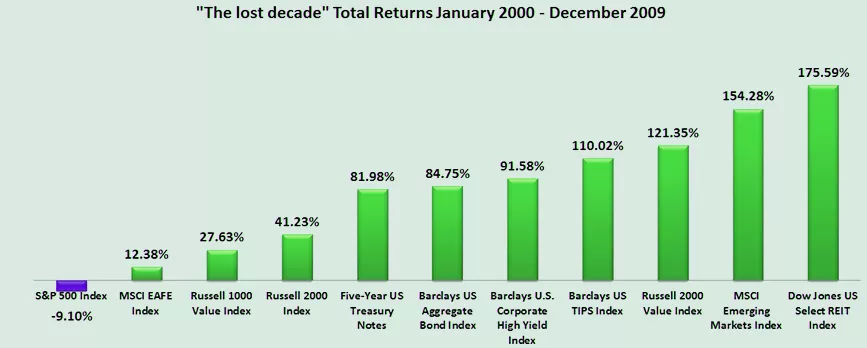The Importance of Diversification
Investors often have a lot to consider. But few investment decisions matter more than asset allocation. A well diversified portfolio is as important for millennials as it is for retirees. Ideally you want to create a diversified portfolio so you don’t have all your money sitting in one type of asset. This is because when one investment underperforms, it won’t necessarily affect others. So if you have your investments spread across a wide range of asset types, then you reduce the risk to your portfolio overall. For example, holding a basket of stocks will reduce volatility and risk compared to holding only one or two stocks. Furthermore, holding a basket of different types of investments will likely create more stable returns over time than only investing in one asset type.
The time span between 2000 to 2009 is sometimes referred to as the “lost decade” because investors who only had investments in the stock market most likely didn’t make any money since the https://www.investor.gov/introduction-investing/investing-basics/glossary/regulation-d-offeringsS&P 500 index returned negative 9.1% during this time. However, a diversified portfolio that held other asset classes and in different parts of the world would have most likely gone up in value.

5 Common Diversification Mistakes Made by Investors
A popular belief is that younger individuals should invest more in equities (stocks) and older people should buy more bonds. Some like to use the “100 minus your age” rule to determine asset allocation. Start with the number 100 and subtract your age. The resulting figure is the percentage you should allocate to equities, and the rest should be invested in bonds. For example a 40 year old index investor could hold the following two low-cost funds in the proportions outlined below.
60%: Vanguard Total World Stock Index Fund Investor Shares (VTWSX)40%: Vanguard Total Bond Market ETF (BND)
This simple method for deciding one’s asset allocation should create long term growth for the investor, while providing fixed income stability. While it’s not a bad place to start for beginners, there are more factors to consider when creating a truly diversified portfolio. Below are some common mistakes many investors make about diversification and how to avoid them.
1. Being too diversified or not diversified enough.
Not holding enough companies can hurt an investor’s stock portfolio. This is especially true if a disproportional amount of the stocks are within the same sector or industry. For example, nearly all energy stocks took a dive in 2014 when the price of oil plummeted from over $100/barrel to roughly $55/barrel. Being overly concentrated in one area of the stock market increases one’s portfolio risk. Mutual funds and ETFs can be used to avoid this problem because these types of funds hold many different individual stocks within them. But for investors who like to choose individual stocks, the optimal number to own for a well diversified equity portfolio is 20 names or more in various sectors. For those who don’t have time to research individual companies, services such as Betterment provide investment advice and diversified, fully automated investment management to customers for less than the typical cost of a traditional financial adviser.
At the same time, it’s also possible to be overly diversified. This usually happens when someone invests in the same or very similar stocks in different accounts. There’s also no point buying similar mutual funds or ETFs. So if there are two similar stocks or funds, investors should just pick one to invest in. Otherwise it creates inefficiency and tax complications. An appropriate method to manage sector diversification could be to use a company like Betterment, where investors can build their own ETF portfolio with a core focus. Certain types of investments are taxed more favorably than others so being careful about which investment vehicle to buy stocks in is also important.
2. Failing to look beyond conventional investments
Stocks and bonds are the most common asset types in the financial markets. But there are many alternative asset classes which are uncorrelated to each other that are worth considering as well. Here are some examples.
- Real estate or REITs
- Farmland
- Art, jewelry, and other collectables
- Precious metals such as gold and silver
- Preferred shares
- Mortgages or other property loans
- High yield bonds
- Option ETFs
- Private businesses
Some of these alternative asset classes have outperformed the stock market over time. For example, according to CNBC, between 1995 to 2014 farmland investment in the United States has returned 12.7% per year on average. Since it is a hard asset that produces income, some investors have referred to farmland as “gold with a coupon.” Ignoring the alternative investment space could mean missing out on some fairly substantial returns over time.
3. Not paying attention to macro-economic conditions.
U.S. government 10-year bonds today are paying a measly 2.47% interest every year. But ten years ago they were paying at roughly 5.00%, which was twice as much. This means in order to achieve an adequate return on a fixed income portfolio today we would have to mix in riskier investments such as non-investment grade bonds and other higher risk loans. However at some point the risks will not be worth the expected returns. So in a low interest rate environment it may be prudent to lower our exposure to bonds, and increase our holdings in stocks.
But three decades ago those 10-year government issued bonds were paying 15% interest a year due to a more robust economy and higher interest rates. In that kind of situation we want to be overweight in bonds because the 15% annual return is virtually risk free since it’s guaranteed by the U.S. federal government, one of the safest debt issuers in the world.
4. Failing to diversify geographically
One important aspect of diversification that is often overlooked is which country the investments are in. Asset allocation is very important of course. But what’s equally important is asset location. It’s understandable for people to be most attracted to companies that do business within their domestic markets because they are more familiar with them. This is known as home country bias.
But as portfolio manager Ben Carlson CFA, explains, sometimes the U.S. stock market represented by the S&P 500 performs well. But other times, developed markets outside of North America (MSCI EAFE) give higher returns.
Diversification works whether you want it to or not http://t.co/lpAHEOSc06 pic.twitter.com/DPI5l6w5qu
— Ben Carlson (@awealthofcs) November 21, 2014
The United States only represents about 20% of the global stock market by market capitalization. So it’s important to diversify our portfolio geographically so we can take advantage of the economic growth in Asia, Europe, and other continents around the world.
Recommended Stock Investing Posts:
5. Ignoring personal circumstances.
A rule of thumb is generally based on the average investor. The problem with following rules is that individuals are not average. If a young person has saved up some money, what should he invest in? It’s impossible to give a categorical answer to this question without knowing the individual’s personal circumstances. If he plans to buy a home in a couple of years using his savings as a down payment then he should probably avoid risky investments and be 100% in short term bonds. On the other hand if he has no plans to purchase a big ticket item, and he works for the government and has a generous fixed income retirement plan, then he should probably invest more of his savings into growth stocks.
If a senior widow in her seventies has money to invest, the knee jerk assumption might be for her to load up on bonds and other conservative, income producing assets. But if she can already live comfortably on the income she receives from insurance benefits, a private pension, and social security, then maybe she should invest more of her personal savings into alternative options.
Using age as an initial reference point to determine asset allocation can be useful. The 100 minus your age rule is a good place to start. But it ultimately comes down to the individual’s personal situation. Understanding one’s own financial circumstances is paramount to making the right diversification decisions in one’s portfolio.
At the end of the day it’s important to remember that true diversification is about spreading out our risks and protecting us against poor investment results over the long run. Sometimes this means we have to give up the home runs in order to avoid striking out. But if we want to survive major market disruptions and ultimately achieve our investment goals then diversification is the best strategy we have.
Also check out this guide to investing in the stock market for beginners.
Exclusive Bonus: Receive a breakdown of how my personal portfolio is optimally diversified to maximize gains and minimize losses.





Excellent post! All too often, I hear people telling me they don’t have to worry about diversification because they own 40 different stocks. The alternative asset classes you mentioned are vital for getting true diversification. No need to invest in every single one – a person can just start with a couple that he or she is interested in. One last note: several of those alternative investments have tax consequences that investors should do their due diligence on before taking the leap. A little research goes a long way to avoid surprises at tax time.